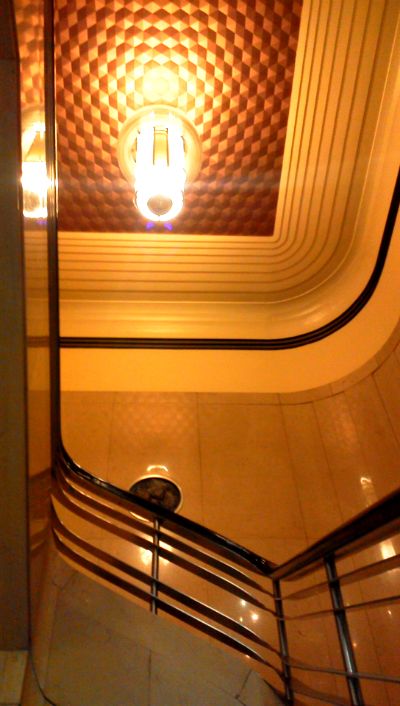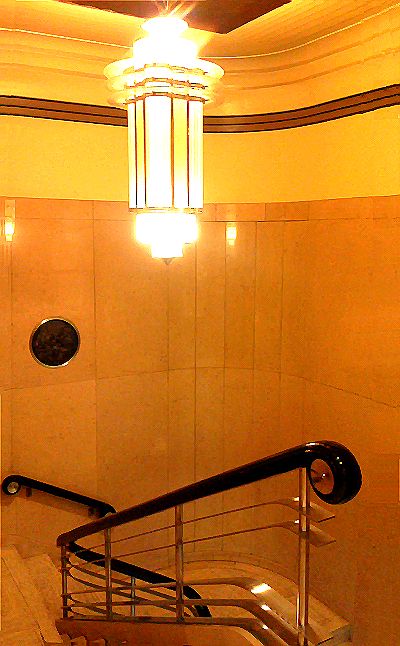
Pope Benedict XVI said when addressing a group of artists assembled in the Sistine Chapel
Beauty, whether that of the natural universe or that expressed in art, precisely because it opens up and broadens the horizons of human awareness, pointing us beyond ourselves, bringing us face to face with the abyss of Infinity, can become a path towards the transcendent, towards the ultimate Mystery, towards God. [Meeting with Artists. Address of His Holiness Benedict XVI. Sistine Chapel. November 29, 2009].
In my last post, I briefly mentioned the idea of a Museum of Beauty. Beauty is best appreciated when it is seen. I think our perception and appreciation of visual beauty surpasses all our other sensory perceptions of beauty. Ideally, there is a plethora of beauty to be seen, from the buildings we pass by, to the gardens we walk through, and the dresses we see on people. I say ideally, because these days, we are living in a cult of ugliness, and finding beauty is like a thirsty wanderer in a desert finding water.
At one time, people created their surroundings with beauty in mind. They knew that what they saw affected them deeply, from the temporary pleasure at the initial viewing of a beautiful object, to the deeper connection beauty (the beautiful object) instills over time.
If one's surroundings are ugly, why bother to preserve them, or live in them?
I think this is the impasse we have reached now.
I cannot redesign our modern world around beauty, but I can try to create small islands of respite where beauty can be viewed and appreciated.
I hope my blog provides such a place. But the ephemeral world of the internet is not enough. We need concrete places where our thirsty eyes can be filled with the wonders of beauty
My idea is to create a Museum of Beauty.
This is not as far-fetched as it sounds. There are the following kinds of museums:
- The Museum of Natural History in New York, which looks at Nature
- The Museum of War, in Ottawa Canada
- The Museum of Science and Technology, in Washington D.C.
There is even a
Museum of Bad Art (which I term as a Museum of Ugliness). So why not a museum of beauty?
There are many questions to answer. One of which is: Aren't there enough museums which show beautiful things already?
Yes, there is the Louvre in Paris, the Metropolitan in New York, and many other smaller museums and galleries around the Western world which show art and other objects which are beautiful. But there is none that I can find which exclusively looks at beauty.
And modern curators are not interested in beauty. And the collections which they preside over which show beautiful objects are from past eras and centuries. Modern museums and curators do not want beauty in their museums. This often results with horrific and horrible things displayed in these museums, and museum visitors are hijacked to view them without complaint.
Creating a museum around a concept isn't a far-fetched idea.
Here are the working titles of my book project
Reclaiming Beauty, around which the various sections of the museum can be created:
An Introduction to Beauty
- Seek and Ye Shall Find
- Beauty, Truth and Goodness
- Synthesis of Beauty
- Beauty in the Worship of God
- Beauty and the Transcendent
- Beauty and Humanity
- Beauty and Femininity
- Beauty and Masculinity
- How to be a Beautiful Movie Star
- Beauty: I will be your mirror
- Rejecting Beauty
- Elimination of Beauty
Beauty in Art
- Architecture
- Painting
- Drawing and Illustrations
- Film
- Photography
- Dance
- Design and Fashion
- Art Criticism
Beauty in Language
- Literature
- Poetry
- Writing
- Books
- Blogging
- Humor
Beauty in Culture and Society
- Religion
- Christianity
- Islam
- Myths and Legends
- History
- Traditions
- Conservatism
- Politics
- Immigration
- Multiculturalism
Beauty in Nature
Beauty in Science
Desecration of Beauty
Reclaiming Beauty
Even the last two chapters, Desecration of Beauty and Reclaiming Beauty are important. It is necessary for people to
see how our modern world is destroying beauty,and how this is historically unprecedented: No other civilization aimed to destroy beauty. And I feel it is important to give guidance on how we can reclaim this beauty lost, since ordinary people have been subliminally hijacked into accepting ugliness as the norm.
I equate this "seeing" with Christianity. From the very beginning, God shows us his presence, perhaps the earliest being when he appeared as a burning bush to Moses, and later gave him tablets to read, with scripted words, rather than words to memorize and recount to the Israelites. These became the visual, written words: The Ten Commandments.
The ultimate revelation, at least in our era, is that of Jesus, who came to show us that God wasn't an entity in the heavens, but a real being, who disclosed himself to us as a human being through Jesus.
And the first words in Genesis, the very beginning of the Bible, are:
And the earth was without form, and void; and darkness was upon the face of the deep. And the Spirit of God moved upon the face of the waters.
And God said, Let there be light: and there was light.[see below for verses 1-31]
The light to see things, to view his beautiful creations.
But, light also enables us to differentiate and discern the beautiful from the ugly, and by extended logic to discard the ugly, or to reshape it to become beautiful.
In those first verses of Genesis, we do not read about the wonderful
sound of the seas:
And God called the dry land Earth; and the gathering together of the waters called he Seas: and God saw that it was good
.
We are presented with "the seas" as a
visual differentiation between land and water. We may love the sound of the bubbling brook, but it is foremost its vision, with the grass and rocks around it, that captures our imagination.
Pope Benedict XVI said when addressing a group of artists assembled in the Sistine Chapel
Beauty, whether that of the natural universe or that expressed in art, precisely because it opens up and broadens the horizons of human awareness, pointing us beyond ourselves, bringing us face to face with the abyss of Infinity, can become a path towards the transcendent, towards the ultimate Mystery, towards God. [Meeting with Artists. Address of His Holiness Benedict XVI. Sistine Chapel. November 29, 2009].
My post "An Introduction to Beauty: Seek and Ye Shall Find"
expands on this.
So, a beauty museum, or a Museum of Beauty, can continue with this movement of "Reclaiming Beauty."
-----------------------------------------------------Genesis 1
1 In the beginning God created the heaven and the earth.
2 And the earth was without form, and void; and darkness was upon the face of the deep. And the Spirit of God moved upon the face of the waters.
3 And God said, Let there be light: and there was light.
4 And God saw the light, that it was good: and God divided the light from the darkness.
5 And God called the light Day, and the darkness he called Night. And the evening and the morning were the first day.
6 And God said, Let there be a firmament in the midst of the waters, and let it divide the waters from the waters.
7 And God made the firmament, and divided the waters which were under the firmament from the waters which were above the firmament: and it was so.
8 And God called the firmament Heaven. And the evening and the morning were the second day.
9 And God said, Let the waters under the heaven be gathered together unto one place, and let the dry land appear: and it was so.
10 And God called the dry land Earth; and the gathering together of the waters called he Seas: and God saw that it was good.
11 And God said, Let the earth bring forth grass, the herb yielding seed, and the fruit tree yielding fruit after his kind, whose seed is in itself, upon the earth: and it was so.
12 And the earth brought forth grass, and herb yielding seed after his kind, and the tree yielding fruit, whose seed was in itself, after his kind: and God saw that it was good.
13 And the evening and the morning were the third day.
14 And God said, Let there be lights in the firmament of the heaven to divide the day from the night; and let them be for signs, and for seasons, and for days, and years:
15 And let them be for lights in the firmament of the heaven to give light upon the earth: and it was so.
16 And God made two great lights; the greater light to rule the day, and the lesser light to rule the night: he made the stars also.
17 And God set them in the firmament of the heaven to give light upon the earth,
18 And to rule over the day and over the night, and to divide the light from the darkness: and God saw that it was good.
19 And the evening and the morning were the fourth day.
20 And God said, Let the waters bring forth abundantly the moving creature that hath life, and fowl that may fly above the earth in the open firmament of heaven.
21 And God created great whales, and every living creature that moveth, which the waters brought forth abundantly, after their kind, and every winged fowl after his kind: and God saw that it was good.
22 And God blessed them, saying, Be fruitful, and multiply, and fill the waters in the seas, and let fowl multiply in the earth.
23 And the evening and the morning were the fifth day.
24 And God said, Let the earth bring forth the living creature after his kind, cattle, and creeping thing, and beast of the earth after his kind: and it was so.
25 And God made the beast of the earth after his kind, and cattle after their kind, and every thing that creepeth upon the earth after his kind: and God saw that it was good.
26 And God said, Let us make man in our image, after our likeness: and let them have dominion over the fish of the sea, and over the fowl of the air, and over the cattle, and over all the earth, and over every creeping thing that creepeth upon the earth.
27 So God created man in his own image, in the image of God created he him; male and female created he them.
28 And God blessed them, and God said unto them, Be fruitful, and multiply, and replenish the earth, and subdue it: and have dominion over the fish of the sea, and over the fowl of the air, and over every living thing that moveth upon the earth.
29 And God said, Behold, I have given you every herb bearing seed, which is upon the face of all the earth, and every tree, in the which is the fruit of a tree yielding seed; to you it shall be for meat.
30 And to every beast of the earth, and to every fowl of the air, and to every thing that creepeth upon the earth, wherein there is life, I have given every green herb for meat: and it was so.
31 And God saw every thing that he had made, and, behold, it was very good. And the evening and the morning were the sixth day.
-------------------------------------------------------------------------------------------------------------------------------------------------------------
Posted By: Kidist P. Asrat
-------------------------------------------------------------------------------------------------------------------------------------------------------------























